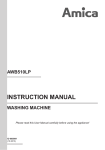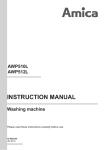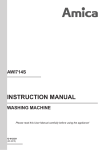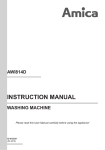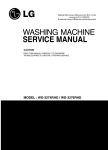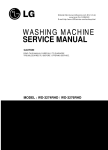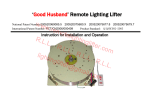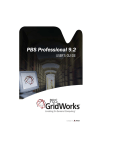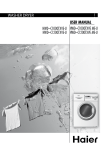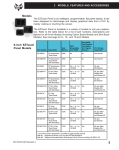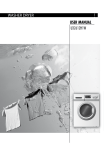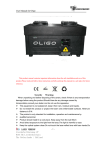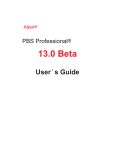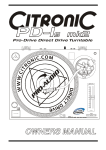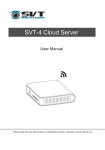Download INSTRUCTION MANUAL
Transcript
AWE512L INSTRUCTION MANUAL WASHING MACHINE Please read this User Manual carefully before using the appliance! IO 00532/1 (01.2012) CONTENTS Basic Information........................................................................................3 Notes on Safety............................................................................................................4 Installing the Washing Machine........................................................................................6 Understanding the symbols on clothes labels..................................................................8 Description of control panel.............................................................................9 Using the appliance................................................................................11 Table of programmes..............................................................................12 Troubleshooting..................................................................................14 Maintenance and Cleaning..................................................................................15 Practical Hints on Washing..............................................................................16 Specification.................................................................................19 Service and Warranty.......................................................................................19 Technical Description................................................................................20 In accordance with European Directive 2002/96/EC and Polish legislation regarding used electrical and electronic goods, this appliance is marked with the symbol of the crossed-out waste container. This marking means that the appliance must not be disposed of together with other household waste after it has been used. The user is obliged to hand it over to waste collection centre collecting used electrical and electronic goods. The collectors, including local collection points, shops and local authority departments provide recycling schemes. Proper handling of used electrical and electronic goods helps avoid environmental and health hazards resulting from the presence of dangerous components and the inappropriate storage and processing of such goods. 2 BASIC INFORMATION From today, washing will be easier than ever before. The Amica washing machine combines exceptional ease of use with excellent effectiveness. Once you have read the instructions, operating the washing machine will not be a problem. Before being packed and leaving the factory, the safety and functions of this washing machine were carefully tested. These tests may have resulted in some damp or traces of water being left inside the machine. We ask you to read the User Manual carefully before switching on the appliance. Following the directions in this manual will protect you from any misuse. Keep this User Manual and store it near at hand. The instructions should be followed carefully to avoid any unfortunate accidents. Important! This washing machine is intended for purely domestic use to wash textiles and clothes which are designed to be machine washed in a detergent bath. Before plugging the washing machine into the mains, remove the safety packaging and ensure the machine is level. The manufacturer reserves the right to introduce changes which do not affect the operation of the appliance. Use lThe machine should only be used after the instructions below have been read carefully. lNever use the machine outdoors or anywhere the temperature may fall below freezing. lThe machine should not be operated by children or anyone who has not read the instructions. Important! Temperatures below 0°C can damage the washing machine! In the event of the machine being stored or transported in sub-zero temperatures, it should be left to acclimatise in a temperature above zero for 8 hours before being used. Manufacturer’s Declaration The manufacturer hereby declares that this product meets the requirements of the following European directives: l Low Voltage Directive 2006/95/EEC, l Electromagnetic Compatibility (EMC) Directive 2004/108/EEC l ErP 2009/125/EEC and has thus been marked with the symbol and been issued with a declaration of compliance made available to market regulators. 3 NOTES ON SAFETY lCleaning agents Use only those cleaning and purifying agents which are designed for automatic washing machines, particularly on the COTTON 90°C setting. Do not use any agents containing solvents, as these may damage certain parts of the machine, or cause them to emit poisonous gases. There is also a risk of ignition and explosion. lLoading the Ensure no unwanted objects are allowed inside the machine. Completely empty all pockets in clothing to be washed and fasten buttons and zips. Place small, loose objects in a washing bag, or inside a pillow case, as they may be destroyed or else damage the drum or internal tank. Do not exceed the recommended maximum load of washing. Machine lControl Panel Protect the control panel from water spillage. Do not put washed clothes on top of the machine! lTransport Unplug the machine before preparing the machine for transport. Do not transport the washing machine if drum locking bolts are not in place. See the chapter INSTALLING THE MACHINE (page 6). Keep the machine in a vertical position when transporting. lData Plate On the upper back part of the casing is the data plate indicating basic information about the washing machine. lBurns The window and door of your washing machine are hot during operation. Do not allow children in the vicinity of the appliance. 4 NOTES ON SAFETY Checking stability Once the washing machine is in position and levelled, it must be checked to ensure it is standing stably on all four legs. This is checked by pressing down each corner in turn and seeing if the machine moves. Safe, long-term and reliable operation of the washing machine depends on it being correctly positioned and level. Important! Before switching the machine on wait 3 hours, level it out and remove the drum locking bolts. Important! Incorrect levelling, particularly instability, may cause the washing machine to move around while operating. This appliance is not intended for use by persons (including children) with physical, mental or sensory handicaps, or by those who are inexperienced or unfamiliar with the appliance, unless under supervision or in accordance with the instructions as communicated to them by persons responsible for their safety. Ensure that children do not play with the appliance. Withdrawal from Use To ensure safety, the washing machine must be rendered unsuitable for use once it is worn out. First unplug it and then cut off the power lead. Scrap the machine in line with local rubbish and waste disposal legislation. 5 INSTALLING THE MACHINE I. Remove the transport protection (keep the blocking bolts for future use, e.g. when moving house). lUnscrew the 4 blocking bolts with a lStop up the holes with the stoppers spanner. lRemove the rubber and plastic transport brackets from the sockets along with the washers and bolts. included in the bag of accessories. The safety devices MUST be removed before the washing machine is used! II. Positioning and levelling the machine lDo not place the washing machine on a carpet! lThe floor surface should not be either concave or sloping! lAttention should be paid to the shape of the surface of the floor, so that the entire weight of the appliance rests on its legs (not its body)! lPlace the washing machine on a solid, even surface. lLoosen the nuts (1) with a spanner. lLevel the machine by adjusting the legs (2). lScrew the nuts (1) back in with a spanner. After positioning and levelling the machine, check that it is stable by pressing down each corner and ensuring it does not move! 6 INSTALLING THE MACHINE III. Connecting the water supply Use the new hoses supplied with the machine. Do not re-use hoses. A supply hose with seals is inside the drum of the machine. Water pressure min 0.1 MPa(1 bar), max 0.8 MPa (8 bar). Supply the machine with cold water lafter connecting, make sure the hose is not twisted lafter connecting the hose and the valve, check they are sealed tight lregularly check the condition of the supply hose. IV. Water outflow max 100 cm min 60 cm The outlet hose is at the back of the machine. Fix the outlet hose so that it does not move while the machine is in operation (use the elbow as shown below). Do not place the hose too deep into the outlet pipe! V. Connecting the electric power supply lThe appliance’s mains connection (the socket of the electrical system) should be in a visible and accessible place! lOnly plug the machine into a properly installed socket with an earth pin! lDo not connect to an adaptor or an extension cord! lIn the event of the power lead being damaged, it must be replaced by an authorised technician. lThe electrical system to which the appliance is to be connected must be protected with a 10 A fuse. 7 UNDERSTANDING THE SYMBOLS ON CLOTHES LABELS 90 I. Washing boiling temp. 900 normal temp 600 C delicate normal temp 400 C DO NOT wash! handwash II. Chemical cleaning all solvents all except TRI petrol only DO NOT dry clean! normal low high DO NOT dry! 1500C 2000C DO NOT iron! III. Spin dryer IV. Ironing 1100C Always pay attention to the symbols on garments’ labels when choosing a washing setting. DESCRIPTION OF THE APPLIANCE Control panel Detergent Drawer Drum Door handle Pump filter cover 8 DESCRIPTION OF CONTROL PANEL 1 2 3 4 5 6 1. Programme selector knob Choose the appropriate wash programme as required, depending on the degree of dirt, and type and amount of laundry loaded, which ensures better results and more effective washing. Once the cleaning programme is started, turning the programme selector knob to another position it does not change the previously selected programme. 2. Spin Speed Button Press this button to set the spin speed when water is being pumped out of the washing machine. Press the button to change the setting. 3. Function selection button Press Function selection button to activate Extra Rinse or Easy Iron functions or both of these functions at the same time. Activation of function is indicated by a LED lighting up next to the function name. Caution:Extra Rinse and Easy Iron functions are not available for all programs (see table of washing programs). Some functions cannot be selected at the same time. Extra Rinse function is especially useful when washing underwear and also clothes for people with sensitive skin. Selecting this function causes increased water consumption during rinse cycle. Easy Iron function reduces wrinkles. Once the Rinse ends the washing machine holds laundry in water. This is indicated by a single beep and „easy iron” and „rinse” indicators blink simultaneously. The door remains locked. Then press the START / PAUSE button to begin water discharge and spinning. 4. Wash mode button - Eco / Intensive Press Wash mode button to activate Eco or Intensive functions. Activation of a mode is indicated by a LED lighting up next to the mode name. Caution: Eco and Intensive mode are not available for all programs (see table of washing programs). The modes cannot be selected at the same time. Eco mode shortens the washing time and reduces the general number of rinsing cycles by one. 9 DESCRIPTION OF CONTROL PANEL This mode is useful in the case of washing lightly soiled clothes. It helps save energy and water. Reducing the amount of detergent is also recommended. Intensive mode is useful when washing heavily soiled clothes. Washing time is increased in order to improve washing effects. 4 + 5 Child lock function This function locks function buttons to prevent settings being changed or operation interrupted by children. To set Child Lock during wash cycle, simultaneously press and hold 4 (Wash mode) and 5 (Pre-wash) buttons for approximately 3 seconds. To release Child Lock during the cycle, hold the same buttons down once more for around 3 seconds. Child Lock will be automatically released after the washing cycle is completed. Caution: Activating the Child Lock function is not indicated on the control panel. 5. Prewash The Pre-wash function extends the wash cycle by approximately 20 minutes. The laundry is prewashed at 30°C before the main wash cycle begins. Activation of the Pre-wash function will allow you to achieve excellent washing results without the need to soak the laundry. Pre-wash is recommended when washing heavily soiled laundry. Caution: Pour suitable detergent to detergent drawer marked with symbol before the Pre-wash function is activated. 6. START/PAUSE button The [Start/Pause] button is used to start and pause the appliance. When the washing machine operates, START / PAUSE pilot light is on. When the appliance is in PAUSE mode, START / PAUSE indicator is off, but Wash, Rinse or Spin indicators are on. Caution: During washing machine operation, appropriate LEDs (Wash, Rinse, Spin) indicate the current phase of the wash programme. In PAUSE mode, the LEDs do not flash and are lit up continuously. 10 USING THE APPLIANCE I. Programme selection 1. Set the programme selector knob to the desired programme (see the table further on). 2. Change spin speed or activate available additional functions to modify the programme to your individual needs. 3. Press the [Start/ Pause] button. II. End of the wash cycle 1. When wash cycle is completed, START/PAUSE indicator is flashing and an acoustic signal is sounded. 2. Turn off the water valve 3. Set the programme selection knob to . 4. Unplug the appliance from the mains. III. Cancelling and changing settings Set the programme selector knob to position for several seconds to terminate a programme. Then select the desired wash programme. 11 TABLE OF PROGRAMMES Additional functions available Programme name Temp. [C°] Max. spin speed [rpm] Maximum load [kg] EXTRA RINSE Easy Iron Eco Wash Intensive Wash Prewash (cold water) 1200 5 + + + + + Cottons 40 40° 1200 5 + + + + + Cottons 60 60° 1200 5 + + + + + Cottons 90 90° 1200 5 + + + + + (cold water) 800 2,5 + + + + - x Synthetics 40 40° 800 2,5 + + + + - x Synthetics 60 60° 800 2,5 + + + + - x Delicates 30 30° 800 1,5 + + + + - x (cold water) 400 1,5 + + - + - x Cottons cold Synthetics cold Wool cold Prewas Wool 40 40° 400 1,5 + + - + - x Quick Wash 30 30° 1200 2,5 + + - - - x Main wash only, no rinse - 1200 5 - - - + - x Rinse - 1200 5 - - - - - x Spin - 1200 5 - - - - - x Drain - - 5 - - - - - x 12 TABLE OF PROGRAMMES Detergent drawer Prewash Prewash Basic wash Fabric softener Time [h:min] Instructions regarding types of load + 01:30 Lightly to moderately soiled linen, table linen, bed linen, towels, cotton or linen shirts, etc. + 01:20 Moderately soiled linen, table linen, bed linen, towels, cotton or linen shirts, etc. + 01:38 Heavily soiled linen, table linen, bed linen, towels, cotton or linen shirts, etc. + 02:15 - x 01:15 - x 01:15 - x 01:30 - x 01:00 Very delicate fabrics. - x 00:45 Important! Do not machine wash woollen fabrics if the cloth tag prohibits. - x 01:05 - x 00:30 Ultra short wash cycle for lightly-soiled fabrics. - x 00:35 Only the main wash in cold water, no rinse. The program ends with a spin. - x x 00:18 Rinsing with improving agents, including antistatic or softening additives. Reduce the spin speed when treating very delicate fabrics. - x x x 00:11 Spin-drying after hand washing. - x x x 00:03 Water discharge only - no spinning. Lightly to moderately soiled delicate synthetic clothing (t-shirts, shirts), or synthetic blends of cotton. CAUTION: The washing machine’s operating time is for reference only, and depends on the water supply temperature, load, water pressure and mains voltage. Detergent required, without which washing will be ineffective. Use detergent or fabric softener if necessary. x Do not use detergent or fabric softener. 13 TROUBLESHOOTING The fault indicator lights The washing machine has a system of error Codes, which helps to locate minor operating faults and identify their cause. The error is indicated by LED indicators on the panel [Wash, Rinse, Spin]. In addition to error indication the washing machine beeps and pauses operation. This is indicated by a flashing LED above the Start/Pause button. Alarm Code - The status of individual LED indicators ☼ Reason Solution Washing Rinse Spinning ☼ Door is not closed properly Check that the door is locked; check that laundry is not jammed in the door ☼ Low pressure, no water in the drum Unscrew the water valve, check the water inlet hose and filter, check the water pressure ☼ ☼ Improper water outflow Check the outlet pomp and filter ☼ Excessive foam Check the outlet pomp and filter Others Try to restart or contact the Service Centre tel. 0844815 8880 / 0818 45 46 46 Off On Flash 14 MAINTENANCE AND CLEANING Never clean the product’s casing or plastic parts using solvents or strong, abrasive cleaning agents (e.g. washing powders or creams)! Only use delicate liquid cleaning agents and soft cloths. Do not use sponges. I. Cleaning the pump filter lUnplug the appliance from the mains. lTurn off the water valve. lOpen the filter cover. Clean the pump filter every 20 washes or so. Neglecting to clean the filter causes difficulties in emptying the machine of water! lUnscrew the filter. lRemove the filter. lClean the filter. Replace the filter – repeat in reverse order. II. Cleaning the water supply valve lTurn on the water supply hose lUse forceps to grasp the filter mesh plunger, lRemove and clean the filter (using a brush). Replace the filter – repeat in reverse order. III. Cleaning the detergent drawer – this should be cleaned at least once a month. lRemove the drawer (while pressing the stop). lClean in running water (or using a brush or piece of cloth). 15 lReplace the drawer PRACTICAL ADVICE REGARDING WASHING I.Cleaning and purifying agents Cleaning agents lFollow the manufacturer’s instructions. lPour the cleaning agent into the drawer chamber marked lPour the pre-wash cleaning agent into the drawer chamber marked Fabric softeners added to the rinse lFollow the manufacturer’s instructions. lPour the fabric softener into the drawer chamber marked lDo not exceed the maximum level marked on the container chamber. This agent will be used for the final rinse. II. First wash Before washing for the first time, put it through one high temperature cycle without a load, according to the following procedure: lConnect the washing machine to the electricity mains. lTurn on the water valve lSet the programme selector knob to high temperature wash. l Add the appropriate detergent and press the [Start/ Pause] button. III. Dirt Stubborn stains Before washing garments, apply an additional stain remover according to the instructions Heavily soiled laundry. lOne-off washing of smaller amounts of clothes. lAdd more cleaning agent. lAfter washing very dirty clothes (e.g. working clothes) or garments which are shedding fibres, it is recommended that the washing machine is rinsed out by running a programme cycle at a temperature of 60°C, without a load, e.g. COTTON or SYNTHETICS. Light dirt lSee pt. „Conservation”. IV. Conservation Reducing energy and water consumption I. Cleaning and purifying agents Garments which are only slightly dirty should be washed using the appropriate wash programme, i.e. ULTRA SHORT Extra rinsing is not necessary when the optimum amount of cleaning agent has been used. 16 PRACTICAL ADVICE REGARDING WASHING V. Water hardness Hard water causes stone sediment to form. Information about water hardness is available from the nearest water works. It is advised that water softeners are used for every wash. VI. Power cut (programme memory) Power outage or unplugging the machine does not cancel the setting. This has been memorised and the cycle will continue once the power is restored. Do not open the doors of the washing machine during a power cut. VII. Loading Maximum drum capacity 5 kg: Load the washing into the drum according to the following instructions: lcotton, denim, children’s clothes – max full drum (do not force clothes into the drum as this will reduce the quality of the wash!). lsynthetics - max ½ drum lwool, silk, delicate fabrics - max. approx. 1/3 of the drum. Important! Do not overload the machine! Overloading the machine may cause damage to the clothes being washed! The maximum load amounts depending on the program are given in table of programs. VIII. Even load distribution control The electronic control device includes a load distribution control system. In the event that the system detects uneven distribution of load in the drum, the washing machine will try to relocate it. Sometimes the trials will not be sufficient for the proper location of the clothes (in the case of frotte dressing gowns washed with other types of clothes, ball-shaped sheets which closes several objects inside it). The system may react in the following way: lit may accept the uneven distribution of clothes but will decrease the spin speed lit may not allow spinning as the clothes are distributed unevenly.) In both cases, after the wash is over, open the door of the washing machine, place the laundry manually, close the door and select the spin programme again. 17 PRACTICAL ADVICE REGARDING WASHING IX. Door interlock The washing machine is equipped with an interlock which prevents the door from being opened during washing. Once a washing cycle is complete, the door interlock is automatically released. In order to open the door during the wash program, press PAUSE button and wait about 2 minutes to unlock the door. IMPORTANT! If the temperature inside the drum is high, the door may remain blocked until the water temperature has dropped below 60°C. IMPORTANT! Before opening the door of the washing machine check whether there is water in the drum. X. Delicate fabrics Programme: lSelect the appropriate wash programme (SYNTHETICS, WOOL, DELICATES) Loading: Do not overload the machine, max 1/3 of the drum, see Loading. XI. Dosing According to the cleaning agent manufacturer’s instructions. Too little cleaning agent lThe washing turns grey. lLumps of grease form, stone sediment builds up. Too much cleaning agent lStrong foaming. lIneffective washing, detergent incompletely rinsed from fabrics. 18 SPECIFICATION AWE512L 230V / ~50Hz. 2100 W 10A max 5 kg min 0,1 MPa (1 bar) max 0,8 MPa (8 bar) -Dimensions/Height/Breadth/ Depth 850 / 595 / 470 [mm] -Weight 60 kg -Meets the requirements of EU legislation, PN-EN 60456. standard. -Type -Rated voltage -Rated power -Overcurrent protection -Drum capacity -Water pressure Test result on label according to PN-EN-60456 using wash programme „Cottons 60°C intensive wash.” lwater consumption per wash cycle 39 l lpower consumption 0.85 kWh 19 TECHNICAL CHARACTERISTICS (in accordance with the Regulation of the Minister of the Economy of 20 May 2005 on the requirements for technical documentation, labelling, specification and label templates for appliances) AWE 512L TYPE Energy efficiency class 1) 2) Power consumption [kWh/cycle] A 0,85 2) Washing efficiency class 1) 2) Spin efficiency class A B 1) 2) Spin speed [rpm] 2) 1200 Maximum load [kg] 2) 5 Water consumption [l] 2) 39 Cycle length [min] 2) 177 Average annual consumption of: Electric power [kWh] 170 Water [l] 7800 3) Noise level [dB(A) re 1 pW] washing 60 spinning 76 Energy efficiency classification on a sale from A (very efficient) to G (less efficient). For the wash cycle, „Cottons 60°C intensive wash.” 3) Estimated annual consumption (200 standard wash cycles „Cottons 60°C intensive wash” for a fourperson household). 1) 2) 20 21 22 23 Service Help Line For the UK: please call 0844 815 8880 For Ireland: please call 0818 46 46 46
























